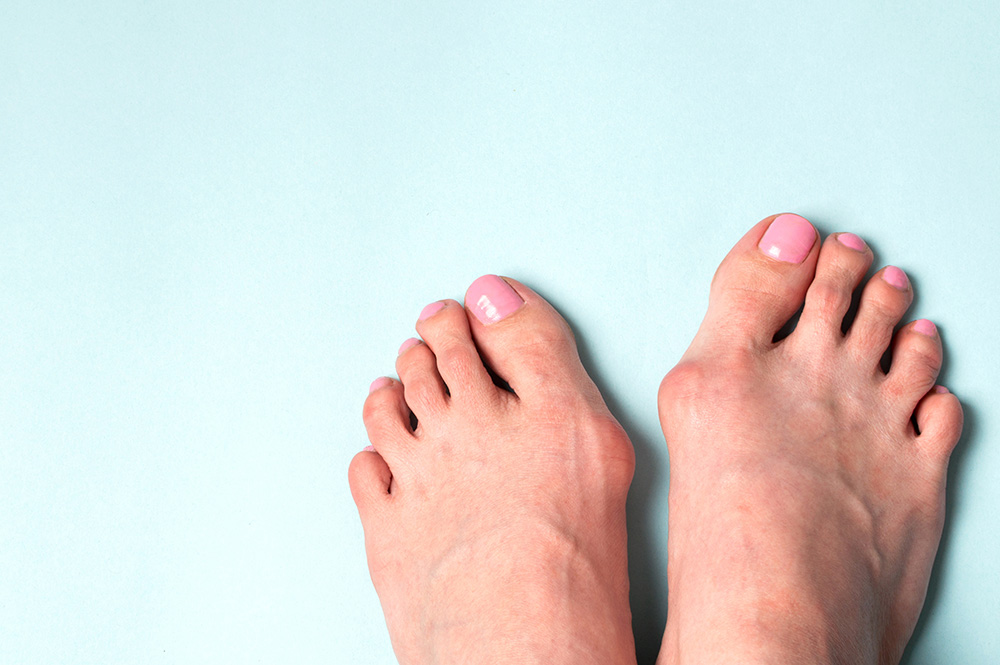
A physician explains what causes bunions and what to know about bunion surgery.
A bunion, medically known as hallux valgus, is one of the most common foot ailments. It presents as a prominent bump on the inside of the foot at the base of the big toe.
Alexander Peterson, MD, an orthopedic surgeon and subspecialist in foot and ankle surgery with USC Orthopaedic Surgery, part of Keck Medicine of USC, shares what you need to know about bunions.
What is a bunion?
Contrary to popular belief, it is not actually a bony growth that creates the bump. Rather, it is a deformity that forms when the bones of the big toe start to point towards the adjacent little toes.
This irregular bending of the big toe causes the joint to “uncover” itself, leading to the rounded bump on the inside of the foot. Think of how the front of the knee becomes “pointier” when the knee is bent. The concept is similar.
What are bunion symptoms?
Some bunions are asymptomatic, manifesting as a bump with no pain. However, many patients with bunions do have bothersome symptoms.
Those who are symptomatic will commonly notice that the skin over the bump on the inside of the foot becomes red, swollen and tender. This leads to pain when wearing shoes that apply pressure on the bump itself. When bunion pain is severe, patients are unable to wear their preferred shoes, especially heels and other forms of tight shoes.
Additionally, as the big toe becomes more crooked, it puts excessive pressure on the toe next to it. In some cases, this causes pain at the contact point between the toes. It can also cause the smaller toes to become crooked themselves, most commonly in the form of hammertoes. Hammertoes are associated with pain at the ball of the foot as well as at the top of the toe itself.
What causes bunions?
The cause of a bunion is often multifactorial. Wearing tight shoes, such as high heels, is a known risk factor for developing a bunion bump. The narrow shoe crowds the toes together and promotes deformity of the big toe.
Genetics have also been found to strongly correlate with development of bunions, with most patients having one or more parents and grandparents with a painful bump.
Women have a much higher rate of bunions, likely due to a mix of shoe wear choices and genetic factors.
Additional factors, such as flat feet and certain neuromuscular conditions, make patients more prone to developing a bunion. In rare cases, a traumatic ligament sprain in the big toe can cause a bunion to form.
I have a bump on my foot. Do I have a bunion?
Although a bunion is the most common reason for having a bump at the base of the big toe, it is not the only cause. Other conditions, such as gout and arthritis, can present with prominence and swelling in the same location. X-rays and examination by an orthopedic foot and ankle surgeon can help clarify the cause of your symptoms.
Will my bunion get worse?
Although most bunions will slowly progress over time in terms of how crooked and painful the foot becomes, the rate of development is difficult to predict. Some patients progress rapidly, while others maintain a small, painless bunion for life.
I have a bunion. Do I need bunion surgery?
The primary determining factor in bunion treatment is pain. A painless bunion does not require any special attention or treatment.
However, when the foot becomes sore, the first line of care should be nonoperative. The most common remedy involves wearing wide shoes that limit pressure on the big toe. This avoids crowding of the toes and rubbing on the bump. In most cases, this alleviates symptoms.
Additional strategies involve wearing pads over the bump or placing a gel spacer between the toes to limit painful crowding. Although there is no product or brace that can reverse a bunion, these tools can reduce or eliminate pain.
If your bunion has progressed to the point that it is painful to walk, carry out your daily activities or wear your desired shoes, you may be a candidate for surgical correction.
What is bunion surgery? Which surgery is right for me?
The basis of bunion correction involves realigning the bones of the foot to maintain a straighter and less painful big toe. Surgery may also require surgical correction of the associated ligaments and tendons. Following bunion surgery, patients can expect resolution of the deformity and, most importantly, relief of their pain.
There are more than 100 described surgical techniques for correcting bunions. These involve various types of bone cuts (known as an osteotomy), soft tissue surgeries as well as bone fusions (surgically healing one bone to another). It is important for your orthopedic foot and ankle surgeon to do a careful exam and review of x-rays to determine which surgery will be best for you.
What is new in the world of bunion surgery?
Whereas traditional bunion surgery required medium-to-large incisions to achieve correction, procedures can now be performed using minimally invasive techniques. This entails correcting the bunion through multiple tiny incisions just millimeters in length.
Studies show that patients who undergo minimally invasive surgeries have less postoperative pain and swelling, leading to easier recoveries. These procedures are technically demanding, however, and require experts with advanced training to perform. Talk to your orthopedic foot and ankle surgeon to see if this approach is appropriate for your bunion correction.
Topics
